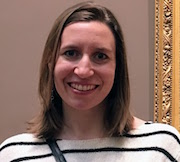
K. Aurelia Ball
AssOCIATE Professor of Chemistry
Office: CIS 310D
Phone: 518-580-8191
Email: kball@skidmore.edu
At Skidmore since 2016
Education
- B.A. Physics 2007, Middlebury College
- Ph.D. Biophysics 2013, University of California, Berkeley
- Postdoctoral Researcher 2013-2016, University of California, San Francisco
- NIH National Research Service Award Postdoctoral Fellow 2015-2016, University of California, San Francisco
Research
My computational biochemistry research program uses computer simulations and other
computational methods to study how intrinsically disordered proteins (IDPs) interact with folded proteins in the context of disease, or as part of normal cellular
function. IDPs are different from typical folded proteins in that they lack a single
well-defined structure and instead dynamically occupy many alternate structures. This
research draws on knowledge from physics, chemistry, biology, and computer science
to understand the fundamental physical principles governing interactions between disordered
and folded proteins and how these interactions are important for their function. One
current project studies how an IDP that is part of the HIV virus interacts with folded
human proteins to change their structure, dynamics, and function. Students in my research
group will investigate biologically important IDP interactions from a physical and
chemical perspective, and learn valuable computational skills. Applying concepts related
to physical chemistry, statistical mechanics, and classical and quantum physics, students
will model proteins and their interactions. In addition, students will have the opportunity
to develop new methods in the analysis of protein dynamics, and collaborate with structural
biologists, biochemists, and computational chemists. Students in the group may also
have opportunities to work on experimental validation of their computational results
using 2D biological NMR or other methods.
I am currently recruiting Skidmore undergraduates interested in biophysical research
and learning computational skills to join my lab. No experience necessary.
Courses
- CH 125 Principles of Chemistry (lecture and lab)
- CH 332 Physical Chemistry I (lab)
- CH 333 Physical Chemistry II (lecture and lab)
- CH 343 Experimental Biochemistry Laboratory
Selected Publications (*Indicates undergraduate co-authors)
- K. A. Ball, L. M. Chan*, D. J. Stanley, E. Tierney*, S. Thapa*, H. M. Ta, L. A. Burton, J. M. Binning, M. P. Jacobson, J. D. Gross. Conformational dynamics of the HIV Vif protein complex. Biophysical Journal, 2019; 116. (link)
- K. Aurelia Ball, Jeffrey R. Johnson, Mary K. Lewinski, John Guatelli, Erik Verschueren, Nevan J. Krogan, Matthew P. Jacobson. Non-Degradative Ubiquitination of Protein Kinases. PLoS Computational Biology, 2016; 12:e1004898.
- Sudhir C. Sharma, Tara Armand*, K. Aurelia Ball, Anna Chen*, Jeffrey G. Pelton, David E. Wemmer, Teresa Head-Gordon. A facile method for expression and purification of 15N isotope-labeled human Alzheimer’s β-amyloid peptides from E. coli for NMR-based structural analysis. Protein Expression and Purification, 2015; 116:82-89.
- K. Aurelia Ball, David E. Wemmer, Teresa Head-Gordon. Comparison of Structure Determination Methods for Intrinsically Disordered Amyloid-β Peptides. The Journal of Physical Chemistry B, 2014; 118:6405-6416.
- Tandis Vazin, K. Aurelia Ball, Hui Lu, Hyungju Park, Yasaman Ataeijannati, Teresa Head-Gordon, Mu-ming Poo, David V. Schaffer. Efficient Derivation of Cortical Glutamatergic Neurons from Human Pluripotent Stem Cells: A model System to Study Neurotoxicity in Alzheimer’s Disease. Neurobiology of Disease, 2014; 62:62-72.
- K. Aurelia Ball, Aaron H. Phillips, David E. Wemmer, Teresa Head-Gordon. Differences in β-strand Populations of Monomeric Aβ40 and Aβ42. Biophysical Journal, 2013; 104:2714-2724. Featured on issue cover.
- K. Aurelia Ball, Aaron H. Phillips, Paul S. Nerenberg, Nicolas L. Fawzi, David E. Wemmer, Teresa Head-Gordon. Homogeneous and Heterogeneous Tertiary Structure Ensembles of Amyloid-b Peptides. Biochemistry, 2011; 50:7612-7628.
- Jory Z. Ruscio, Jonathan E. Kohn, K. Aurelia Ball, Teresa Head-Gordon. The influence of protein dynamics on the success of computational enzyme design. Journal of the American Chemical Society, 2009; 131:14111-14115.
Professional Affiliations
- American Chemical Society (Computational Chemistry)
- Biophysical Society (Intrinsically Disordered Proteins)